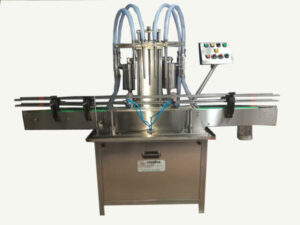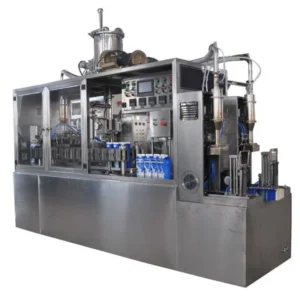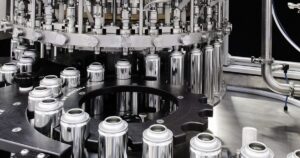Understanding Machines that Fill Milk
To fill up bottles with milk in a way that is accurate and efficient, milk-filling machines are complex pieces of equipment that are designed to do just that. These machines have got advanced technology that ensures measurements are precise, minimal wastage is created while maintaining cleanliness throughout the process of filling. By removing manual labor input, such units considerably increase productivity with a corresponding reduction in contamination hazards.

Key Parts and their Functions
Milk filling machines have different parts that work together perfectly well for proper packaging and accurate filling of dairy products like milk. Here are some of the important components:
Filling Nozzles: responsible for transferring liquid into containers; they can be several in one machine, thereby enabling simultaneous multiple container filling hence increased output capacity.
Conveyor System: It moves empty cans to the filling point and then takes them away after being filled to ensure continuous flow during the production period without stoppages caused by a lack of cans at any given time or place along the line.
Control Panel: Allows an operator to set parameters like fill volume, and speed among other necessary aspects depending on type or size, etc., more so it gives room for monitoring change while still running and looking forward to excellent performance.
Capping and Sealing Mechanism: Some models come complete with this feature which makes packaging easier than ever before possible where what remains is only capping tightly sealed vessels after they have been filled up thus freshness maintained leakages are avoided altogether.
Types of Machines for Filling Milk
These machines come in different designs depending on need or preference concerning particular production demands; examples include;
Automatic Milk Filling Machines: Fully automated systems whose operation requires less human intervention; best suited for establishments involved with large-scale manufacturing where efficiency matters most along with uniformity is least cared about since all batches produced will be mixed during the processing stage anyway before going through the final blending step before packaging them separately according to customer requirements which save both times as well cost incurred due handling many different types manually always.

Semi-Automatic Milk Filling Machines: These fillers need manual labor such as putting containers onto conveyors and starting the filling process through buttons being pressed by operators; they are recommended for use in medium-sized firms where there is a need not only automated but also have individual control over few things done during operation like adjusting speed etc.

Aseptic Milk Filling Machines: Mostly used when products are being packed under sterile conditions so that they can stay fresh longer; lots of bacteria or other microorganisms may be killed during this particular process because it’s carried out under heat sterilization hence ensuring safety even after some time without refrigeration which could have otherwise caused spoilage thus reducing shelf life substantially.

Rotary Milk Filling Machines: These work by rotating platform having many filling stations hence increasing efficiency since the number filled per unit time will be more than any other model available on the market today; besides accommodating a wide range of sizes of shapes of containers utilized within the industry thereby saving space requirement while still meeting customer needs perfectly well without compromising quality whatsoever.

Advantages Associated with the Use of Milk-Filling Machines
Several benefits come along with the implementation milk filling machines among them include the following;
Higher Efficiency: These devices help save a lot of time in taken complete production cycle because everything happens automatically hence no need to wait for somebody else to finish doing his/her task before proceeding further which might lead to the wastage of resources like energy, materials, etc. Thus, labor costs are reduced significantly.
Better Accuracy: Modern fillers are fitted with precision measurement systems to ensure uniform fill volumes every single time leading to less giveaway and more yield realized overall thus improving accuracy levels greatly compared to traditional methods where guesswork is involved in most cases resulting in inconsistent outputs between different batches produced under the same conditions due to lack proper monitoring facilities provided by these new technological advancements now available.
Increased Cleanliness Standards: Such units operate based upon the clean-in-place (CIP) concept and are made from materials that are easily cleanable therefore maintaining hygiene levels high throughout their use thus reducing the chances of contamination happening during the packaging process leading to unsafe products.
Flexibility: These machines are capable of handling a wide variety forms of milk products ranging from pasteurized milk, flavored cream yogurt drinks, etc.; they also can accommodate various sizes shapes, and containers to meet the diverse needs of customers.
What to Consider When Purchasing a Milk-Filling Machine
There are certain factors one needs to consider before buying any given milk-filling machine these include;
Production Capacity: Establish the ideal throughput for your production line so as not to choose a filling machine that is too fast or too slow for it.
Filling Accuracy: Seek machines with accurate gauging systems and fill settings that can be adjusted to make sure fills are even all the time while reducing product waste.
Hygiene Standards: Give priority to those machines that have been built with sanitary features and parts that are easy to clean to meet cleanliness standards set by relevant authorities for healthy food production.
Flexibility: When purchasing a filling machine, select one that allows different types of products, containers, and configurations for filling to cater to future growth and diversification of goods/services offered.
Maintenance and Support: At this stage consider the availability of spares, technical support staff well, and servicing providers because you may need them more often than expected if anything goes wrong thereby cutting down on downtime thus extending the useful life span of such equipment.
Increase Flexibility and Versatility
The other day I was reading about another dairy farmer who had bought some kind of robot milk packer together with an AR maintenance system. The reason why he did this is because his previous packing machine could only do one type at a time but now he can switch between different types without any problems. Additionally, the robots help him save time on maintenance since they show what needs fixing through augmented reality instead of waiting until something breaks down. Because of these improvements, their company has become more productive than ever before!
